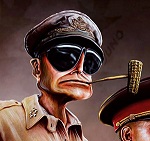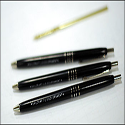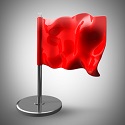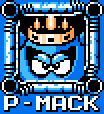|
Jobbo_Fett posted:Depends on the fuzing, if its fuzed of course. They basically all were. The only solid shells I can think of in WWI were for Brit tank guns. A good burster is real important. Phanatic posted:Frequently, they'd go off to scatter their dye-marker payload. Spotting the fall of your shells in relation to your target is crucial for adjusting your aim, and when you have a bunch of ships shooting at the same target you need to be able to tell which ones are your shells and which ones are some other ships, so different ships would have different colors of dye packed into their shells. This is probably universal practice by WWII, I've confirmed the US, Japan and France did it, and have no evidence of a country that didn't.
|
|
|
|

|
| # ? Jun 7, 2024 18:18 |
|
Near-misses can damage a ship due to the incompressibility of water if the explosive payload is large enough (I think it was Akagi that took some crucial damage aft from a divebomber's 500lb bomb that plunked into the water off the stern at Midway. It wasn't a fatal blow at the time but it damaged the rudder and some piping, the latter of which exacerbated the effects of bombs that hit their mark later on) but I don't know how close really qualifies and I bet the armor of a WWI battleship mitigated that blast effect if it didn't blow outside the armor belt.
|
|
|
|
FAUXTON posted:Near-misses can damage a ship due to the incompressibility of water if the explosive payload is large enough (I think it was Akagi that took some crucial damage aft from a divebomber's 500lb bomb that plunked into the water off the stern at Midway. It wasn't a fatal blow at the time but it damaged the rudder and some piping, the latter of which exacerbated the effects of bombs that hit their mark later on) but I don't know how close really qualifies and I bet the armor of a WWI battleship mitigated that blast effect if it didn't blow outside the armor belt. Akagi only took that rear hit and one amidships. Overall the effect's a bit like a torpedo. A bomb like that is something like 15-20 times as much explosive as a shell's burster. Shells, if they drop short, can end up flattening out a bit and hitting underwater. The Japanese put some effort into getting shells to do well at this, and I've seen indications the French had a fancy wind screen for their shells that did something similar. The US and Japan both armored their ships against such hits, although this made them prone to greater flooding from torpedo hits since the armor couldn't flex and could tear away from the ship's bottom. The PoW landed such a hit on the Bismarck, which didn't have armor like that, and caused flooding in a turboelectric generator room and progressive flooding that couldn't be repaired properly at sea that knocked two of her boilers out. The Yamato landed a hit on a US cruiser that was similar (iirc the Salt Lake City) that hit the magazine, but the flooding prevented explosion.
|
|
|
|
Splode posted:Would the shells these battleships fired go off if they missed, or just tragically plop into the ocean? At shell travel speed water is pretty much the same as concrete when impacting it.
|
|
|
|
Splode posted:In the history of firearms, how often is poor ammunition responsible for lovely reliability, and how often is it just lovely gun design? It's pretty common, especially if you include "reliability" to include hitting the thing you shoot at and not just mechanical function. The vast majority of quality in ammo construction comes from putting the exact same powder charge in every cartridge. Different amounts of powder will affect how a bullet flies, and if you have differing amounts across the cartridges in a lot then it is nearly impossible to properly sight in a rifle. There are plenty of designs - especially ones from the USSR and its allies - that have a somewhat undeserved reputation for inaccuracy that is mostly due to the fact that they made some really inconsistently loaded ammo. The Mosin, the AK, and the SKS might not be the pinnacle of precision rifle manufacture, but when they are fed good ammo they aren't nearly as inaccurate as their reputations would have you believe. I've got a WW2 vintage Mosin sniper rifle and if I feed it commbloc bulk rifle/mg ammo from the 70s it shoots for poo poo, but when I give it some quality Russian marksman's ammo from the 90s it's really loving accurate.
|
|
|
|
So I just learned that during the last year of WW2 Goebbels had a film made about the battle of Kolberg of 1807. Thousands of soldiers and over a thousand horses were used as extras, as Goebbels reasoned that they were of more use to Germany that way. It cost over 8 million Reichsmarks and was the most expensive movie produced in war time Germany.quote:To film scenes with snow during summer, 100 railway wagons brought salt to the set in Pomerania. Two extras were killed during the making of the film when an explosive charge went off too early. :psyhitler: And this is the result: https://www.youtube.com/watch?v=z8lTLf2oDSY FYI Finland bought StuG IIIG's from Germany at a cost of 168000 RM a piece. So 8 million RM is some 50 StuGs. Now your home assignment is to calculate how many Shermans Casablanca cost! Cyrano4747 posted:It's pretty common, especially if you include "reliability" to include hitting the thing you shoot at and not just mechanical function. The vast majority of quality in ammo construction comes from putting the exact same powder charge in every cartridge. Different amounts of powder will affect how a bullet flies, and if you have differing amounts across the cartridges in a lot then it is nearly impossible to properly sight in a rifle. There are plenty of designs - especially ones from the USSR and its allies - that have a somewhat undeserved reputation for inaccuracy that is mostly due to the fact that they made some really inconsistently loaded ammo. The Mosin, the AK, and the SKS might not be the pinnacle of precision rifle manufacture, but when they are fed good ammo they aren't nearly as inaccurate as their reputations would have you believe. I've got a WW2 vintage Mosin sniper rifle and if I feed it commbloc bulk rifle/mg ammo from the 70s it shoots for poo poo, but when I give it some quality Russian marksman's ammo from the 90s it's really loving accurate. Good storage also matters. Eg. that Soviet era ammo might have been good once, but who knows in what flooded basement it's been held for all these decades. Nenonen fucked around with this message at 18:06 on Jun 15, 2015 |
|
|
|
Raskolnikov38 posted:At shell travel speed water is pretty much the same as concrete when impacting it. Shells travel a pretty good way underwater if their bursters don't go off.
|
|
|
|
xthetenth posted:Shells travel a pretty good way underwater if their bursters don't go off. They also travel a pretty good way through concrete if their bursters don't go off.
|
|
|
|
The shells typically are not striking the water full-on, so it's not quite like concrete. Also they can pen concrete for a bit. There's only going to be so much movement underwater until the shell slows enough.
|
|
|
|
bewbies posted:I've heard two different theories for the "six thing". Both stem from the fact that, In WWII, radio nets only went down to the regimental level in infantry units. The first is that there were typically five subordinate units on the tactical net in a regiment: the three battalions, the regimental guns, and the anti-tank company. Hence, 1 thru 5, with 6 being the regiment commander. The second is that the regimental commander was a colonel, or O-6, so asking for "the six" meant the commander. I'm not sure if this makes sense because during WWII radio nets were sometimes at the company level, two echelons below the regiment. Although going through my original post it sounds like they were using colors to identify the platoons instead of the modern day methods which would be "Easy 1-6" for the platoon leader of first platoon, Easy company. Same goes for the numbering of staff sections. The battalion or regimental Intel officer wouldn't have an entire callsign to himself, I wouldn't think. The staff sections are not on tactical nets.
|
|
|
|
Taerkar posted:The shells typically are not striking the water full-on, so it's not quite like concrete. Also they can pen concrete for a bit. There's only going to be so much movement underwater until the shell slows enough. You might be interested in the section of Evans and Peattie's _Kaigun: Strategy, Tactics, and Technology in the Imperial Japanese Navy_ which talks about Suichidan, and the Type 91 shell; basically the Japanese were doing test firing on the Tosa and found that a 16 inch shell fired at 20,000 meters, entering the water at 25 meters in front of the target went right under the armor, through the torpedo bulges, and into the engineering spaces, resulting in massive damage. They developed the Type 91 shell specifically to take advantage of this, however, since this was top secret they never actually practiced it during peacetime training. The postwar American Naval Mission concluded that this shell design sacrificed direct hit performance in order to take advantage of this "doubtful hit through the water".
|
|
|
|
Comrade_Robot posted:You might be interested in the section of Evans and Peattie's _Kaigun: Strategy, Tactics, and Technology in the Imperial Japanese Navy_ which talks about Suichidan, and the Type 91 shell; basically the Japanese were doing test firing on the Tosa and found that a 16 inch shell fired at 20,000 meters, entering the water at 25 meters in front of the target went right under the armor, through the torpedo bulges, and into the engineering spaces, resulting in massive damage. They developed the Type 91 shell specifically to take advantage of this, however, since this was top secret they never actually practiced it during peacetime training. The postwar American Naval Mission concluded that this shell design sacrificed direct hit performance in order to take advantage of this "doubtful hit through the water". I believe Last Stand of the Tin Can Sailors mentioned how one of the gunnery chiefs on the Japanese battleships at the Battle Off Samar was trying to do this with the destroyers of Taffy 3 by undershooting deliberately.
|
|
|
|
Fangz posted:I believe Last Stand of the Tin Can Sailors mentioned how one of the gunnery chiefs on the Japanese battleships at the Battle Off Samar was trying to do this with the destroyers of Taffy 3 by undershooting deliberately. Makes sense honestly, I don't think destroyers are that likely to fuze a shell in time for it to explode in them.
|
|
|
|
Fangz posted:I believe Last Stand of the Tin Can Sailors mentioned how one of the gunnery chiefs on the Japanese battleships at the Battle Off Samar was trying to do this with the destroyers of Taffy 3 by undershooting deliberately. When you're drowning, the damndest things look like lifelines.
|
|
|
|
xthetenth posted:Makes sense honestly, I don't think destroyers are that likely to fuze a shell in time for it to explode in them. They didn't, multiple AP shells went clean through the ships unless they hit something especially solid like a turbine casing. Additionally the boat identification skills on display by the IJN at Samar were so atrocious that DEs were being called as heavy cruisers and CVEs as fast fleet carriers.
|
|
|
|
Raskolnikov38 posted:They didn't, multiple AP shells went clean through the ships unless they hit something especially solid like a turbine casing. Additionally the boat identification skills on display by the IJN at Samar were so atrocious that DEs were being called as heavy cruisers and CVEs as fast fleet carriers. Not being good at identification skills was something of a universal thing among navies during WW2.
|
|
|
|
ALL-PRO SEXMAN posted:Not being good at identification skills was something of a universal thing among navies during WW2. For some reason, through, the Japanese scout plane pilots were especially bad at this. For instance at Coral Sea the Fleet Oiler Neosho and Destroyer Sims somehow became "1 carrier, a heavy cruiser and 3 destroyers". The Japanese wasted their entire carrier strike on these two ships, leading directly to the sinking of Shoho.
|
|
|
|
ALL-PRO SEXMAN posted:Not being good at identification skills was something of a universal thing among navies during WW2. Polikarpov posted:For some reason, through, the Japanese scout plane pilots were especially bad at this. For instance at Coral Sea the Fleet Oiler Neosho and Destroyer Sims somehow became "1 carrier, a heavy cruiser and 3 destroyers". A few months later, an American (or Australian, can't remember) pilot called the cruiser strike group heading towards the battle of Savo Island as gunboats and seaplane tenders, though, which probably helped produce that particular clusterfuck.
|
|
|
|
Nenonen posted:So I just learned that during the last year of WW2 Goebbels had a film made about the battle of Kolberg of 1807. Thousands of soldiers and over a thousand horses were used as extras, as Goebbels reasoned that they were of more use to Germany that way. It cost over 8 million Reichsmarks and was the most expensive movie produced in war time Germany. I looked it up, and it appears to have been filmed in 43-44, where everyone knew they were hosed, but they weren't directly at the gates. But jesus christ. This is what happens when you have a bunch of barely accountable fiefdoms working towards the fuhrer.
|
|
|
|
I kind of what a english subtitled version of that. Hilariously good production values considering what was going on in real life at the time.
|
|
|
|
Hummer Driving human being posted:I'm not sure if this makes sense because during WWII radio nets were sometimes at the company level, two echelons below the regiment. Although going through my original post it sounds like they were using colors to identify the platoons instead of the modern day methods which would be "Easy 1-6" for the platoon leader of first platoon, Easy company. I thought colors were more commonly used. Red, white, blue for line platoons. Green/brown for weapons. Black for hq. On the company/platoon nets, black 6 actual is the co. On the BN net, *company callsign* 6 is the company co. etc.
|
|
|
|
|
Of course, all the smart armies use 0 for command call-signs, leaving 1-9 all free and assignable for subordinate units. But that's just common sense, which weighs nothing next to tradition.
|
|
|
|
Taiping Tianguo Part 1 Part 2 Part 3 Part 4 Part 5 Part 6 Part 7 Retreat and Reload Following the disaster at Suoyi Ford, the Taiping army pulled itself back together and turned south, seeking a safe place to regroup and rebuild. The original plan to take Yongzhou and continue north towards Changsha has been rendered impossible by the loss of their boats. The sudden change in direction takes the city of Daozhou by surprise, and it is easily taken. This affords an opportunity for the wandering army of Guangxi God Worshippers to rest and reorganize, but it's clear that this force alone will not be enough for the struggles ahead. they will need to start recruiting. As mentioned earlier, the Taiping movement had both political, economic, religious, and ethnic dimensions, and they needed to decide which to emphasize for this first massive propaganda campaign. In the end, they decide to go all in on anti-manchu rahowa. The Manchu race was born when a dog hosed a fox, and has only gotten more degenerate in the time elapsed since. They have taken our land, taken our women, etc. Some of the more unique accusations is that by imposing the queue, they have tried to turn the Chinese into tailed animals by means of hairstyle. they have also enacted a campaign to distort, pollute, and corrupt the proper pronunciation of Chinese language (this corrupt Manchu form of Chinese is known today as Mandarin). The abysmally poor Manchu response to floods and other disasters is not merely the result of bankruptcy incompetence, but an intentional plan to keep the Chinese population down to a manageable level. The missives end by pointing out the massive population disparity between the Chinese and Manchu, and suggesting that the only way the Manchu can continue their domination is if the Chinese are a bunch of chickens. There's plenty of hyperbole, but the essential point is that the Manchu government is corrupt, ineffective, and often brutal (in particular, rebellion was punished by killing all relatives to nine degrees of separation). They put hard times on the Heavenly king and his family. This message will ring true for much of the Chinese lower classes. While the Confucian gentry are horrified, the peasantry responds to the call, and soon 20,000 new recruits arrive. Among these Hunanese recruits are many miners, whose tunneling experience will prove invaluable in the battles to come. The anti-marxist interpretation will note the absence of any reference to particular classes in Taiping propaganda. Marxist will respond by pointing out that the response to this propaganda will largely divide along class lines. Make of that what you will. In addition to the boyz, the Taiping need more dakka, and forge 300 cannon to prepare for the fights to come. After a month in the Daozhou area, they move on to Chenzhou, the next city on the path to Changsha. Despite consideration of returning to Guangxi, the decision has been made to press onward toward the north, towards the heart of the empire. In Chenzhou, they gather another 20,000 men. While numbers swell, many of the new recruits are secret society members or former bandits, and the famed Taiping discipline will slip somewhat with the incorporation of less ideologically committed soldiers. Siege of Changsha The Taiping do not linger long in Chenzhou. Xiao Chaogui, the Western King, leads a few thousand men on a rapid march to attempt to take the provincial capital of Changsha by surprise attack, assisted by commanders Li Kaifeng and Lin Fengxiang. They unleash a furious artillery bombardment, but their unfamiliarity with the city prevents them from concentrating their fire to maximum effect, and the city gates are closed and blocked just in time. Luo Bingzhang, Hunan's governor, is one of the more competent imperial commanders, and he swiftly coordinates the defense with only about 6,000 soldiers. Realizing this will not be sufficient, he rapidly sends out a call for help. If the Taiping had not been delayed by the debacle at Suoyi Ford, giving Luo four precious months to repair the defenses of the city and gather reinforcements, Xiao likely would have taken the city, with tremendous ramifications for the future of the war. Xiao was a tremendously brave and swole commander, but his personal bravery will set him up for a familiar tragedy. Leading at the front lines, his yellow and black dragon robe will prove an irresistible target for a defending gunner who sends a cannonball through Xiao's shoulder. Like Feng Yunshan, before him, Xiao lingers for a time before dying. The Taiping have lost another wang, and Li and Lin bring the news back to Yang, still in Chenzhou preparing the rest of the army to move on Changsha. The loss of Xiao is crucial, as not only are his talents as a commander lost, but so is his position as a counterweight to the influence of Eastern King Yang Xiuqing. From this point on, Yang is for all practical purposes sole executive leader of the movement, as Hong is concerned more with religious and political proclamations, while Wei Changhui and Shi Dakai lack the rank and prestige to counteract Yang's influence. The Taiping continue to seek to take Changsha despite this setback. They advance up both banks of the river. Shi Dakai on the west bank will hold off imperial reinforcement from that direction. A system of pontoon bridges link the two sides of the river and the important island of Shuiluozhou, from which the river can be effectively controlled. Xiang Rong tries twice to take the island and fails twice, losing 3000 men each time. Meanwhile the Taiping tuying, 土營 "earth battalions" of miners have been tunneling under the walls. The imperial forces try to detect these by placing drums in the earth and holding ears to them to detect noises and underground vibrations. Supposedly, blind men are specially recruited for this task. Their daredevil senses prove useful, and most tunnels are detected and stopped either by flooding them or dropping heavy stones on them. A few tunnels successfully make it under the walls, and massive explosions create several large breaches. The Taiping fail to take the breaches, however. Because the city was too large to encircle, Luo has continued to receive reinforcements, and with 50,000 soldiers and militia, the city is now more safe from the Taiping. Up the Yangtze The Taiping show an admirable ability to realize when it is time to cut bait, and leave Changsha, taking boats downriver. They move north to Yuezhou. Xiang Rong begs the city to hold out, promising relief in three days, but the garrison flees almost immediately. The Taiping seize a wealth of supplies, gather recruits, and also meet Tang Zhengcai, a talented shipbuilder who will almost immediately be put in charge of the Taiping navy. The Taiping have learned from the Suoyi disaster, and land-naval coordination from this point on is impeccable. The Taiping commandeer ships as needed, burn them when they abandon them, and leave imperial pursuit in the dust. They advance up theYangtze and rapidly reach Hanyang and Hankou, which, along with Wuchang on the opposite bank, constitute an economically and strategically crucial triple city. The cities are practically undefended, and easily taken, along with a great number of boats and supplies. The next step will be to take Wuchang, seizing control of the Yangtze and leaving the Taiping free to strike anywhere in the empire.  Just a mini update today. Sorry to all of you wondering when we're going to get to
|
|
|
|
What do naval encounters look like during the Taiping Rebellion? I'm imagining junks with lots of guys lined up on deck shooting matchlocks and rockets, or was it more sophisticated?
|
|
|
|
Squalid posted:What do naval encounters look like during the Taiping Rebellion? I'm imagining junks with lots of guys lined up on deck shooting matchlocks and rockets, or was it more sophisticated? Most of these boats are commandeered civilian vessels, so yeah, nothing too sophisticated. They'll start using cannon equipped gunboats, but nothing too crazy in terms of firepower. Western steamships with modern cannon will vastly outclass anything the Taiping or imperialists have available, and this will be a big deal later in the war. To give an idea, sources list the Taiping as having 10,000+ boats for a 100,000 man army, so you can assume most vessels are relatively small. P-Mack fucked around with this message at 02:51 on Jun 16, 2015 |
|
|
|
Does anyone have any opinions about Norman Davies? Also, how do you feel about this paragraph, which is from No Simple Victory?quote:Within this overall kaleidoscope, the position of the Ukrainians was particularly complicated. They were the largest Soviet minority (around 18 per cent), and they spoke a language that is as close to Russian as Dutch is to German (Deutsch). Indeed, they had always been treated by the tsarist and Soviet authorities as the Russians' 'younger brothers, who would lead the way towards Russification and Sovietization. Ukrainian nationalism therefore was of necessity anti-Russian. And the fact that a separate Ukrainian state had been set up with German help in 1918-21 made it specially suspect. As a result, Stalin's persecutions in Ukraine were merciless. Well over 10 million Ukrainians were killed in the 1930s, if not by the policy of forced collectivization, then by the terror-famine of 1932-3 and the Great Terror. If only the Nazis could have thought to accept the Kaiser's policies of twenty-five years earlier the course of history would have been very different. As it was, betrayed by the Germans and humiliated by the Russians, the Ukrainians had little option but to suffer the next wave of war and occupation with stoicism. The surprising thing is not how many Ukrainians volunteered to join the Wehrmacht, but how few.
|
|
|
|
Squalid posted:What do naval encounters look like during the Taiping Rebellion? I'm imagining junks with lots of guys lined up on deck shooting matchlocks and rockets, or was it more sophisticated?
|
|
|
|
Rent-A-Cop posted:Even a very big river is tight quarters for naval fighting so I imagine there was a lot of ramming and boarding going on. When a mommy ship and a daddy ship love each other very much, they have a special hug that they use to show that love. That hug makes new life in the form of little boats, which is why they're called lifeboats.
|
|
|
|
cheerfullydrab posted:Does anyone have any opinions about Norman Davies? Also, how do you feel about this paragraph, which is from No Simple Victory? Not sure about the man himself, but the paragraph has some truth to it. I have a book that covers all the foreign volunteers/units, I believe by Christopher Bishop, that explores the fact that the Nazis didn't immediately seek out volunteers soon after conquering new territories that may have been sympathetic to them (The Baltic States, Ukraine, etc.). A classic "Too little, too late" move of the Nazis was to try to recruit as many people as possible as the war progressed and, by that time, volunteers were more hesitant because they didn't want to join the losing side.
|
|
|
|
cheerfullydrab posted:Does anyone have any opinions about Norman Davies? Also, how do you feel about this paragraph, which is from No Simple Victory? In short, some Ukrainians joined the Wehrmacht, but the best way for a Ukrainian to resist tyranny was to join the Ukrainian People's Army. But that organization is highly controversial because they killed more Polish civilians and Red Army soldiers than they did Nazis. It's true that the Ukrainians were horribly oppressed by the Soviets, and some fought for the Nazis because they saw them as a way to free Ukraine from tyranny. The Soviet government killed far more Ukrainians than the Nazis did, so the Ukrainian nationalists who resisted tyranny initially sided with the Nazis to try to win Ukraine's independence. Stepan Bandera, leader of the Organization of Ukrainian Nationalists (Revolutionary), appointed Jews to positions of power in his organization, but didn't try to save Jews from the death camps because he felt it would hurt the cause of Ukrainian independence. In late 1941 the Nazis went to war against the OUN-R and their military, the Ukrainian People's Army, and put Bandera in a concentration camp. The OUN-R, no longer concerned with staying friends with the Nazis, began helping Jews escape the Holocaust. In 1943 the UPA and a disbanded Jew-hunting Ukrainian nationalist Nazi brigade started to massacre Polish people living in the disputed territory Galicia, in the hopes of restoring it to an independent Ukraine. They killed about 100,000 Poles before Roman Shukhevych became the leader of the UPA later in 1943 and turned its focus to fighting against all totalitarian governments in Ukraine. He fought against the Nazis until the Red Army drove them out in 1944, then fought against the Soviet occupiers until his death in 1950. Since Shukhevych was siding against the Red Army when they recaptured Ukraine, the Nazis released Bandera in 1944. Bandera and Shukhevych are divisive figures, deeply complicated by the recent fighting in Ukraine. Viktor Yushchenko awarded them both the title Hero of Ukraine and within months, Viktor Yanukovych stripped them both of the award. Yanukovych, you may recall, was the guy who started the fighting in 2014 when he ordered security forces to kill dozens of peaceful protesters. Supporters of the Russia-backed rebels often throw around "Banderite" as an insult, with Putin describing Bandera as "Hitler's accomplice". Bandera should have done more to try to save holocaust victims, and Shukhevych was likely an accomplice to some massacres (though he later helped a Jewish child escape the Nazis). They're both flawed people, but they're also the best symbols Ukraine has of resistance to Russian military incursion, which is why Russian propaganda wanted to rewrite history and turn them into utter monsters.
|
|
|
|
Davies is a good historian with a slight bias towards Eastern European opinions compared to most of his colleagues working in the West.
|
|
|
|
Phanatic posted:Frequently, they'd go off to scatter their dye-marker payload. Spotting the fall of your shells in relation to your target is crucial for adjusting your aim, and when you have a bunch of ships shooting at the same target you need to be able to tell which ones are your shells and which ones are some other ships, so different ships would have different colors of dye packed into their shells. I would like to know more.
|
|
|
|
Groda posted:I would like to know more. Yeah, I love asking questions in this thread, you guys know the coolest, weirdest stuff.
|
|
|
|
Hmmm, the guy who wrote A World Undone really loving hates Haig, huh?
|
|
|
|
Groda posted:I would like to know more. As Phanatic said, spotting the fall of shot was important: you have to know by how much you missed by to know how much you need to adjust for. This informed naval strategy in fairly broad terms. If you had two battle lines of ships exchanging fire, it was important for the lead ship of one line to shoot the lead ship of the other line, and for the second to shoot its counter-part, and so on and so forth. If you had two ships shooting the same target, it was that much harder for either individual attacker to determine which splashes were theirs. If you have an equal number of ships on both battle lines, but one target is getting shot at by two ships, that means one ship isn't getting shot at all, which then means that that ship gets to shoot more accurately since it's not being harassed nor hit. If I recall my WWI naval history correctly this was actually a big deal during the Battle of Dogger Bank, where two Royal Navy Battlecruisers were doubled up on a single German BC due to a miscommunication. It also mattered in terms ship design: one of the Dreadnought's key innovations (on top of all the others it already had) was a single set of big guns that were all supposed to fire together at the same range at the same target. Prior to it, a battleship might have a mixture of 3-inch, 6-inch and 12-inch guns. If a target was in range of both your 6-inch and your 12-inch guns, and you fired them together, which splashes were which? Finally, specific to what Phanatic said, the IJN (and I'm sure other navies also, but I don't have specifics) used dyes on their shells so ships could tell which splashes were from which ships and from which guns, especially since you couldn't count on a more "orderly" battle line as in the 1900s-1920s. Eyewitness accounts of the Battle of Samar tell us that the sea was awash in pinks, greens, yellows and oranges.
|
|
|
|
I checked out of tracking all the cheap shots Meyer takes after the seventeenth LOL ALL-HIGH WARLORD joke about the Kaiser. Just about the only useful thing I got from that book was "every time you're going to be rude about someone, have a new good reason for it, or else it gets very tiresome very quickly". 100 Years Ago Charge! Second Artois resumes, the Battle of Bellewaarde goes off, the Italians are at it as well. The sum total? At least at Bellewaarde, the BEF has found a new way to fail. And there's glimmers of original thinking near Caporetto, but don't worry, they'll soon be snuffed out. At least Second Artois is there to give us our RDA of high-level incompetence and ridiculous over-optimism. Meanwhile, behind the lines, there's important milestones in the development of landships in both Britain and France.
|
|
|
|
How did they decide which ship gets which color of dyed shells? Those must have been funny meetings.
|
|
|
|
tonberrytoby posted:How did they decide which ship gets which color of dyed shells? Those must have been funny meetings. "Pink? Why do I gotta have the pink shells?" "Cos' you're the captain of the USS human being, alright?"
|
|
|
|
MikeCrotch posted:"Pink? Why do I gotta have the pink shells?"
|
|
|
|

|
| # ? Jun 7, 2024 18:18 |
|
Tekopo posted:Hmmm actually depending on the time period, people would have wanted the pink dye because it was tied with boys at the time. The shift occurred during the 30s/40s, cementing itself at the end of that latter decade. Real Men Wear Pink
|
|
|















































